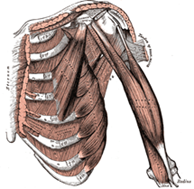 Pectoralis minor tightness is a common finding in people with shoulder dysfunction. We’ve discussed how to stretch the pec minor in the past with mixed results – it’s a hard muscle to stretch well. There are a few techniques I like to perform including pinning the muscle and relaxing in a positional release that fits my reverse posturing theory. Chris Johnson has recently shared with me another great manual techniques that he has put a lot of thought and research into.
Pectoralis minor tightness is a common finding in people with shoulder dysfunction. We’ve discussed how to stretch the pec minor in the past with mixed results – it’s a hard muscle to stretch well. There are a few techniques I like to perform including pinning the muscle and relaxing in a positional release that fits my reverse posturing theory. Chris Johnson has recently shared with me another great manual techniques that he has put a lot of thought and research into.
Stretching the Pec Minor
Decreased length of the pectoralis minor is a common impairment in patients presenting with shoulder dysfunction and musculoskeletal imbalances such as the “upper crossed syndrome.” Restrictions in pec minor length are problematic because they cause scapular protraction, loss of posterior scapular tilt, inhibition of the lower trapezius, and decreased width of the subacromial space. Identifying optimal treatment regimens is therefore critical to engender successful outcomes for patients exhibiting decreased pec minor length. Currently, a dearth of research exists pertaining to the most effective approach for improving the length of this muscle.
Borstad and Ludewig (J Shoulder Elbow Surg 2006) have conducted the only study to date, which specifically investigated the efficacy of three pectoralis minor stretches. Their results demonstrated that a corner stretch was superior to a supine and seated manual stretch. As Mike has mentioned, however, the corner stretch may subject the anterior capsule to deleterious forces, and patients need to be closely monitored to ensure proper execution of this stretch.
The technique in the below video is what I have anecdotally found to be the safest and most effective approach for increasing pectoralis minor length. This technique was predominantly influenced by the work of Shirley Sahrmann, Thomas Meyers, and Vladimir Janda, and involves a myofascial stretch followed by a retraining exercise of the posterior shoulder musculature. For the stretch portion of the technique, make sure that your pressure is applied at the level of the coracoid process (insertion of the pectoralis minor & origin of the short head of the biceps) rather than the humerus and direct your force into posterior scapular tilt. I generally hold this stretch for 90 seconds and repeat it 5 times based on the work of Magnusson et al (Scan J Med Sci Sports 1995).
Avoid applying excessive pressure distally at the level of the wrist as it may cause discomfort in the elbow region. Immediately following each stretch, I have the patient maintain the newly lengthened position for 10 seconds to retrain the posterior shoulder musculature, particularly the lower trapezius.
As part of a home program, I also have my patients assume anatomical position for 30 seconds periodically throughout the day to facilitate carryover. I specifically instruct them to stand with their feet shoulder width apart, gently tighten their abdominal wall, rotate their hands so the palms are facing forward, draw their shoulder blades down and back towards their back pants pockets, and gently retract the chin. I use this exercise as a postural “reset” anytime one finds themselves crossing their arms or assuming a hands on hips position.
I am confident that you will find this technique to be a “game changer” and I look forward to hearing your thoughts on it. I would also like to personally thank Mike for giving me the opportunity to share my clinical thoughts on his blog as well as Force Therapeutics for allowing me to share this video.
Chris Johnson – http://www.chrisjohnsonpt.com
Thanks for sharing Chris, I like it! Yet another tool in our belt! Try this stretch out and leave some feedback, I want to hear what everyone else thinks.
Sign up for my FREE newsletter for even more great content!




